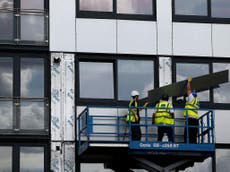Government stumps up extra £3.5bn for highrise cladding – but the plan is full of holes
Those living in buildings over 18m will have their cladding issues fixed but those under that height will have to make do with loans. Both the government and the industry can do better, writes James Moore


Three-and-half-years since 72 people were killed in the Grenfell fire, tower block residents are still living in buildings containing combustible cladding and wondering: is it going to be me next?
That’s three-and-a-half years of soaring insurance premiums, homes which have become impossible to sell and leaseholders contemplating bankruptcy as the fire safety bills roll in while developers continue to announce record profits.
The derelict remains of the tower stand in mute testimony to the dismal response of a government that has moved at the speed of a sloth stuck in quicksand in response to all this.
The £3.5bn of extra money announced by housing secretary Robert Jenrick to fix the problem in buildings over 18m in height is a big number. But the plans have been branded as a "betrayal" by campaigners.
No wonder. They contain more holes than a kitchen colander.
The £3.5bn announced comes on top of an earlier £1.6bn. Those living in buildings above 18m in height in England will now have unsafe cladding removed and replaced at no cost.
The trouble is, 18m is a completely arbitrary number. A couple of inches the wrong side of that and you’re left with a loan scheme. Leaseholders won’t pay more than £50 a month. But it’s still a loan, which means a new bill of £50 a month in the midst of an economic crisis with a tidal wave of job cuts on the way.
Jenrick said the cost shouldn’t fall on the taxpayer and so there will be a levy targeted at developers seeking to build certain highrise buildings in England to help meet it. There’s also a new tax for the UK residential property sector coming in next year.
Now here’s the thing: part of the reason developers have done so well is that they have, in effect, been subsidised by the taxpayer through the government’s help-to-buy scheme.
It provides people with cheap mortgages to get on to the housing ladder. But when the National Audit Office looked at it a couple of years back it found that nearly two-thirds of the recipients didn’t actually need the scheme's help for their purchases.
It had, by December 2018, advanced £11.7bn, with the number forecast to hit £25bn by 2023 and has repeatedly been blamed by economists for pumping amphetamines into house prices, and pouring money into developers pockets as a result. Is it any wonder with numbers like that?
The scheme has ended up subsidising developers far more than it has subsidised home buyers.
That being the case, it isn’t unreasonable, with so many people stuck in unsafe homes they can’t sell, to ask the people who profited handsomely from building them to contribute to fixing the problems they made. And to ask them for more than the mooted £2bn that government is proposing to raise so everyone can be covered.
It’s cheap, as some developers have argued, that the buildings they put up complied with the regulations at the time. An unsafe building is an unsafe building.
Prior to Jenrick’s announcement, Persimmon announced it would take a provision of £75bn towards fixing the cladding in highrise developments it built. This is not as simple as the group saying “we’ll deal with this no questions asked”.
Chairman Roger Devlin said: “Where we still own the building we will act. Where we no longer own them we will work with the owners to make sure they meet their legal responsibilities and duty [to handle the issue]. If the owner does not step up then we will act to remove uncertainty and anxiety for residents and make the buildings safe.”
Still, it’s better than nothing and of the 26 Persimmon built developments identified as potentially having problems, 17 are under 18m. Persimmon has had its results pump primed by help to buy.
Other developers which have similarly profited from the taxpayer through this scheme should take note. Both the government and the industry could and should do better.
“The government promised us no leaseholder would have to pay to make their homes safe. Today we feel betrayed. We were hoping for a solution to stop the sleepless nights and for millions living in buildings less than 18m there has been none,” said campaign group End Our Cladding Scandal.
“Taxpayers and leaseholders are left to foot the bill for billions of pounds while the largest developers – who have made over £10bn in profit since the Grenfell fire – are let off lightly.”
Indeed. And yet this is where we are three-and-a-half years after the Grenfell disaster.



Join our commenting forum
Join thought-provoking conversations, follow other Independent readers and see their replies
Comments